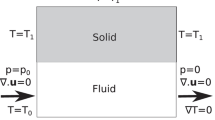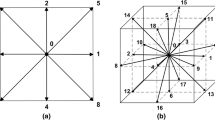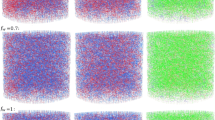Abstract
We present a solute transport model, developed by employing a dynamic pore network modeling approach, to investigate dispersive solute transport behaviors in consolidated porous media. The model is capable of upscaling solute transport processes from pore to core, under two-phase fluid configurations. The governing equations of fluid flow, fluid displacement, and solute transport are solved at the pore level. A heavily parallelized computing scheme is utilized to simulate dynamic fluid displacements and transport processes in a core-scale pore network constructed from micro-computed tomography (micro-CT) images of a Berea sandstone sample. A series of solute transport simulations are conducted under the single-phase condition to validate the model by comparing the computed longitudinal dispersion coefficients against the experimental data over a wide range of Peclet numbers (Pe), i.e., \(3 \times 10^{-2}{\sim}3 \times 10^5\). The model is then used to simulate solute transport under two-phase fluid configurations to examine the effects of the non-wetting phase saturation on solute transport behaviors. More specifically, solute transport is studied at different Pe and different water saturations obtained at the end of imbibition processes. We find that in a two-phase system, the longitudinal dispersion coefficient substantially increases with enhanced convective mixing under the transport regime with high Pe but decreases with restricted diffusive mixing at low Pe. In addition, the results indicate a non-monotonic dispersion–saturation relation under the convective transport condition. We illustrate that a strong correlation exists between the extent of dispersive mixing and the heterogeneity of fluid saturation profile across a core-scale network.















Similar content being viewed by others
References
Acharya, R., Van der Zee, S., Leijnse, A.: Approaches for modeling longitudinal dispersion in pore-networks. Adv. Water Resources 30(2), 261–272 (2007)
Aghaei, A., Piri, M.: Direct pore-to-core up-scaling of displacement processes: dynamic pore network modeling and experimentation. J. Hydrol. 522, 488–509 (2015)
Aris, R.: On the dispersion of a solute in a fluid flowing through a tube. Proc. R. Soc. Lond. Ser. A Math. Phys. Sci. 235(1200), 67–77 (1956)
Aziz, R., Joekar-Niasar, V., Martinez-Ferrer, P.: Pore-scale insights into transport and mixing in steady-state two-phase flow in porous media. Int. J. Multiphase Flow 109, 51–62 (2018)
Babaei, M., Joekar-Niasar, V.: A transport phase diagram for pore-level correlated porous media. Adv. Water Resources 92, 23–29 (2016)
Balay, S., Abhyankar, S., Adams, M.F., Brown, J., Brune, P., Buschelman, K., Dalcin, L., Eijkhout, V., Gropp, W.D., Kaushik, D., Knepley, M.G., May, D.A., McInnes, L.C., Rupp, K., Sanan, P., Smith, B.F., Zampini, S., Zhang, H., Zhang, H.: PETSc users manual. Tech. Rep. ANL-95/11 - Revision 3.8, Argonne National Laboratory (2017)
Berkowitz, B.: Characterizing flow and transport in fractured geological media: a review. Adv. Water Resources 25(8), 861–884 (2002)
Bijeljic, B., Blunt, M.J.: Pore-scale modeling of transverse dispersion in porous media. Water Resources Res. 43(12), 1 (2007)
Bijeljic, B., Muggeridge, A.H., Blunt, M.J.: Pore-scale modeling of longitudinal dispersion. Water Resources Res. 40(11), 1 (2004)
Blackwell, R., Rayne, J., Terry, W.: Factors influencing the efficiency of miscible displacement. Trans. AIME 217(1), 1–8 (1959)
Blunt, M.J.: Physically-based network modeling of multiphase flow in intermediate-wet porous media. J. Pet. Sci. Eng. 20(3–4), 117–125 (1998)
Boggs, J.M., Young, S.C., Beard, L.M., Gelhar, L.W., Rehfeldt, K.R., Adams, E.E.: Field study of dispersion in a heterogeneous aquifer: 1. Overview and site description. Water Resources Res. 28(12), 3281–3291 (1992)
Brigham, W.E., Reed, P.W., Dew, J.N.: Experiments on mixing during miscible displacement in porous media. Soc. Pet. Eng. J. 1(01), 1–8 (1961)
Carberry, J.J., Bretton, R.H.: Axial dispersion of mass in flow through fixed beds. AIChE J. 4(3), 367–375 (1958)
Cushman, J.H.: The Physics of Fluids in Hierarchical Porous Media: Angstroms to Miles, vol. 10. Springer, Berlin (2013)
Delshad, M., MacAllister, D., Pope, G.A., Rouse, B., et al.: Multiphase dispersion and relative permeability experiments. Soc. Pet. Eng. J. 25(04), 524–534 (1985)
Dillard, L.A., Blunt, M.J.: Development of a pore network simulation model to study nonaqueous phase liquid dissolution. Water Resources Res. 36(2), 439–454 (2000)
Dong, H., Blunt, M.J.: Pore-network extraction from micro-computerized-tomography images. Phys. Rev. E 80, 036307 (2009). https://doi.org/10.1103/PhysRevE.80.036307
Dullien, F.A.: Porous Media: Fluid Transport and Pore Structure. Academic Press, London (2012)
Ebach, E.A., White, R.R.: Mixing of fluids flowing through beds of packed solids. AIChE J. 4(2), 161–169 (1958)
Edwards, M., Richardson, J.: Gas dispersion in packed beds. Chem. Eng. Sci. 23(2), 109–123 (1968)
Frosch, G.P., Tillich, J.E., Haselmeier, R., Holz, M., Althaus, E.: Probing the pore space of geothermal reservoir sandstones by nuclear magnetic resonance. Geothermics 29(6), 671–687 (2000)
Gaber, H., Inskeep, W., Wraith, J., Comfort, S.: Nonequilibrium transport of atrazine through large intact soil cores. Soil Sci. Soc. Am. J. 59(1), 60–67 (1995)
Garmeh, G., Johns, R.T., Lake, L.W.: Pore-scale simulation of dispersion in porous media. SPE J. 14(04), 559–567 (2009)
Gong, Y., Gu, Y.: Experimental study of water and co2 flooding in the tight main pay zone and vuggy residual oil zone of a carbonate reservoir. Energy Fuels 29(10), 6213–6223 (2015)
Hasan, S., Joekar-Niasar, V., Karadimitriou, N.K., Sahimi, M.: Saturation dependence of non-Fickian transport in porous media. Water Resources Res. 55(2), 1153–1166 (2019)
Honari, A., Zecca, M., Vogt, S.J., Iglauer, S., Bijeljic, B., Johns, M.L., May, E.F.: The impact of residual water on ch4-co2 dispersion in consolidated rock cores. Int. J. Greenhouse Gas Control 50, 100–111 (2016)
Hui, M.H., Blunt, M.J.: Effects of wettability on three-phase flow in porous media. J. Phys. Chem. B 104(16), 3833–3845 (2000). https://doi.org/10.1021/jp9933222
Jha, R.K., Bryant, S., Lake, L.W.: Effect of diffusion on dispersion. SPE J. 16(01), 65–77 (2011)
Kantzas, A., Bryan, J., Taheri, S.: Fundamentals of fluid flow in porous media. http://perminc.com/resources/fundamentals-of-fluid-flow-in-porous-media/ (2018)
Karadimitriou, N.K., Joekar-Niasar, V., Babaei, M., Shore, C.A.: Critical role of the immobile zone in non-Fickian two-phase transport: a new paradigm. Environ. Sci. Technol. 50(8), 4384–4392 (2016)
Karadimitriou, N.K., Joekar-Niasar, V., Brizuela, O.G.: Hydro-dynamic solute transport under two-phase flow conditions. Sci. Rep. 7(1), 1–7 (2017)
Karypis, G., Kumar, V.: A fast and high quality multilevel scheme for partitioning irregular graphs. SIAM J. Sci. Comput. 20(1), 359–392 (1998). https://doi.org/10.1137/S1064827595287997
Khrapitchev, A., Callaghan, P.: Reversible and irreversible dispersion in a porous medium. Phys. Fluids 15(9), 2649–2660 (2003)
Legatski, M.W., Katz, D.L.: Dispersion coefficients for gases flowing in consolidated porous media. Soc. Pet. Eng. J. 7(01), 43–53 (1967)
Li, L., Peters, C.A., Celia, M.A.: Upscaling geochemical reaction rates using pore-scale network modeling. Adv. Water Resources 29(9), 1351–1370 (2006)
Li, S., Raoof, A., Schotting, R.: Solute dispersion under electric and pressure driven flows; pore scale processes. J. Hydrol. 517, 1107–1113 (2014)
Maier, R.S., Kroll, D.M., Bernard, R.S., Howington, S.E., Peters, J.F., Davis, H.T.: Pore-scale simulation of dispersion. Phys. Fluids 12(8), 2065–2079 (2000)
Maraqa, M.A., Wallace, R.B., Voice, T.C.: Effects of degree of water saturation on dispersivity and immobile water in sandy soil columns. J. Contam. Hydrol. 25(3–4), 199–218 (1997)
Mayer, R.P., Stowe, R.A.: Mercury porosimetry—breakthrough pressure for penetration between packed spheres. J. Colloid Sci. 20(8), 893–911 (1965). https://doi.org/10.1016/0095-8522(65)90061-9
Mehmani, A., Mehmani, Y., Prodanović, M., Balhoff, M.: A forward analysis on the applicability of tracer breakthrough profiles in revealing the pore structure of tight gas sandstone and carbonate rocks. Water Resources Res. 51(6), 4751–4767 (2015)
Mohanty, K.K., Salter, S.J.: Multiphase flow in porous media: Ii. pore-level modeling. In: SPE Annual Technical Conference and Exhibition. Society of Petroleum Engineers (1982)
Mostaghimi, P., Bijeljic, B., Blunt, M.: Simulation of flow and dispersion on pore-space images. SPE J. 17(04), 1–131 (2012)
Naveed, M., Hamamoto, S., Kawamoto, K., Sakaki, T., Takahashi, M., Komatsu, T., Wollesen de Jonge, L., Lamandé, M., Moldrup, P.: Gas dispersion in granular porous media under air-dry and wet conditions. Soil Sci. Soc. Am. J. 76(3), 845–852 (2012)
Oak, M.: Three-phase relative permeability of water-wet Berea. In: SPE/DOE Enhanced Oil Recovery Symposium. Society of Petroleum Engineers (1990)
Oostrom, M., Mehmani, Y., Romero-Gomez, P., Tang, Y., Liu, H., Yoon, H., Kang, Q., Joekar-Niasar, V., Balhoff, M.T., Dewers, T., et al.: Pore-scale and continuum simulations of solute transport micromodel benchmark experiments. Comput. Geosci. 20(4), 857–879 (2016)
Oren, P.E., Bakke, S., Arntzen, O.: Extending predictive capabilities to network models. SPE J. 3(4), 324–336 (1998). https://doi.org/10.2118/52052-PA
Ovaysi, S., Piri, M.: Pore-scale modeling of dispersion in disordered porous media. J. Contamin. Hydrol. 124(1), 68–81 (2011)
Padilla, I.Y., Yeh, T.C.J., Conklin, M.H.: The effect of water content on solute transport in unsaturated porous media. Water Resources Res. 35(11), 3303–3313 (1999)
Patzek, T., Silin, D.: Shape factor and hydraulic conductance in noncircular capillaries: I. one-phase creeping flow. J. Colloid Interface Sci. 236(2):295–304. https://doi.org/10.1006/jcis.2000.7413(2001)
Perkins, T., Johnston, O.: A review of diffusion and dispersion in porous media. Soc. Pet. Eng. J. 3(01), 70–84 (1963)
Pfannkuch H (1963) Contribution a l’etude des deplacements de fluids miscibles dans un milieu poreux. Rev. Inst. Fr. Pet. 18:215–270
Picard, G., Frey, K.: Method for modeling transport of particles in realistic porous networks: Application to the computation of NMR flow propagators. Phys. Rev. E 75(6), 066311 (2007)
Piri, M., Blunt, M.J.: Three-phase threshold capillary pressures in noncircular capillary tubes with different wettabilities including contact angle hysteresis. Phys. Rev. E 70(6), 061603 (2004)
Piri, M., Blunt, M.J.: Three-dimensional mixed-wet random pore-scale network modeling of two- and three-phase flow in porous media. I. Model description. Phys. Rev. E 71:026301, https://doi.org/10.1103/PhysRevE.71.026301(2005)
Princen, H.: Capillary phenomena in assemblies of parallel cylinders: I. Capillary rise between two cylinders. J. Colloid Interface Sci. 30(1):69–75. https://doi.org/10.1016/0021-9797(69)90379-8 (1969a)
Princen, H.: Capillary phenomena in assemblies of parallel cylinders: Ii. capillary rise in systems with more than two cylinders. J. Colloid Interface Sci. 30(3):359 – 371, https://doi.org/10.1016/0021-9797(69)90403-2 (1969b)
Pruess, K., Yabusaki, S., Steefel, C., Lichtner, P.: Fluid flow, heat transfer, and solute transport at nuclear waste storage tanks in the Hanford vadose zone. Vadose Zone J. 1(1), 68–88 (2002)
Qin, C.Z., Hassanizadeh, S.M.: Pore-network modeling of solute transport and biofilm growth in porous media. Transp. Porous Med. 110(3), 345–367 (2015)
Raoof, A., Hassanizadeh, S.: Saturation-dependent solute dispersivity in porous media: pore-scale processes. Water Resources Res. 49(4), 1943–1951 (2013)
Raoof, A., Hassanizadeh, S.M., Leijnse, A.: Upscaling transport of adsorbing solutes in porous media: pore-network modeling. Vadose Zone J. 9(3), 624–636 (2010)
Rhodes, M.E., Bijeljic, B., Blunt, M.J.: Pore-to-field simulation of single-phase transport using continuous time random walks. Adv. Water Resources 31(12), 1527–1539 (2008)
Rifai, M.N.E., Kaufman, W.J., Todd, D.K.: Dispersion Phenomena in Laminar Flow Through Porous Media. University of California, Sanitary Engineering Research Laboratory and Division of Civil Engineering (1956)
Sahimi, M., Imdakm, A.: The effect of morphological disorder on hydrodynamic dispersion in flow through porous media. J. Phys. A: Math. Gen. 21(19), 3833 (1988)
Sahimi, M., Davis, H.T., Scriven, L.: Dispersion in disordered porous media. Chem. Eng. Commun. 23(4–6), 329–341 (1983)
Sahimi, M., Heiba, A.A., Davis, H.T., Scriven, L.: Dispersion in flow through porous media—ii. Two-phase flow. Chem. Eng. Sci. 41(8), 2123–2136 (1986)
Salter SJ, Mohanty KK (1982) Multiphase flow in porous media: I. macroscopic observations and modeling. In: SPE Annual Technical Conference and Exhibition, Society of Petroleum Engineers
Seymour, J.D., Callaghan, P.T.: Generalized approach to NMR analysis of flow and dispersion in porous media. AIChE J. 43(8), 2096–2111 (1997)
Silliman, S., Simpson, E.: Laboratory evidence of the scale effect in dispersion of solutes in porous media. Water Resour. Res. 23(8), 1667–1673 (1987)
Singh, K., Menke, H., Andrew, M., Lin, Q., Rau, C., Blunt, M.J., Bijeljic, B.: Dynamics of snap-off and pore-filling events during two-phase fluid flow in permeable media. Sci. Rep. 7(1), 1–13 (2017)
Stalkup, F.I.: Displacement of oil by solvent at high water saturation. Soc. Petrol. Eng. J. 10(04), 337–348 (1970)
Stöhr M (2003) Analysis of Flow and Transport in Refractive Index Matched Porous Media. PhD thesis, University of Heidelberg, Germany
Taylor, G.I.: Dispersion of soluble matter in solvent flowing slowly through a tube. Proc. R. Soc. Lond. A 219(1137), 186–203 (1953)
Yao, J., Thovert, J., Adler, P., Burganos, V., Payatakes, A., Moulu, J., Kalaydjian, F.: Characterization, reconstruction and transport properties of Vosges sandstones. Revue-Institut Francais du Petrole 52, 3–22 (1997)
Zhang, X., Bengough, A.G., Deeks, L.K., Crawford, J.W., Young, I.M.: A novel three-dimensional lattice Boltzmann model for solute transport in variably saturated porous media. Water Resources Res. 38(9), 1 (2002)
Zhou, D., Blunt, M., Orr Jr., F.: Hydrocarbon drainage along corners of noncircular capillaries. J. Colloid Interface Sci. 187(1), 11–21 (1997)
Acknowledgements
We gratefully acknowledge the financial support of Thermo Fisher Scientific and the School of Energy Resources at the University of Wyoming. We also thank Dr. Behzad Reza Ahrabi for his assistance with the implementation of the PETSc package. Dr. Mohammad Sedghi, Dr. Bradley William McCaskill, and Dr. Saeid Khorsandi of Piri Research Group at the Center of Innovation for Flow through Porous Media of the University of Wyoming are thanked for the helpful discussions.
Author information
Authors and Affiliations
Corresponding author
Additional information
Publisher's Note
Springer Nature remains neutral with regard to jurisdictional claims in published maps and institutional affiliations.
Appendix 1
Appendix 1
1.1 Area Open to Flow and Phase Conductance
For a single-phase filled element, its cross-sectional area open to flow is:
where R and G are the inscribed radius and shape factor of the element, respectively. The phase conductance is then obtained with the following equations (Oren et al. 1998; Patzek and Silin 2001):
where \(\mu \) is the fluid viscosity.
For a two-phase filled element with oil occupying the center and water residing in the corner, the corner area open to water flow can be calculated by utilizing the geometrical relationship:
and the Young–Laplace equation:
where \(A^w\) is the cross-sectional area of the water layer in a specific corner, \(\alpha \) is the corner half angle, b is the apex-meniscus distance, \(\sigma ^{ow}\) is the interfacial tension (IFT) between oil and water, and \(\theta \) is the angle between the oil–water interface and the solid surface toward the corner. It can be the contact angle or hinging angle depending on the local capillary pressure. In Eq. 23 and as shown in Fig. 3, r is the radius of the AM interface, whose curvature in the plane perpendicular to that of the paper is assumed to be negligible. The area open to oil flow is readily available:
where n is the number of corners that are occupied by water.
In this case, the center oil conductance is evaluated using \(A^o\) and Eq. 21, while the corner water conductance is given by (Zhou et al. 1997; Hui and Blunt 2000):
Rights and permissions
About this article
Cite this article
Gong, Y., Piri, M. Pore-to-Core Upscaling of Solute Transport Under Steady-State Two-Phase Flow Conditions Using Dynamic Pore Network Modeling Approach. Transp Porous Med 135, 181–218 (2020). https://doi.org/10.1007/s11242-020-01475-0
Received:
Accepted:
Published:
Issue Date:
DOI: https://doi.org/10.1007/s11242-020-01475-0




